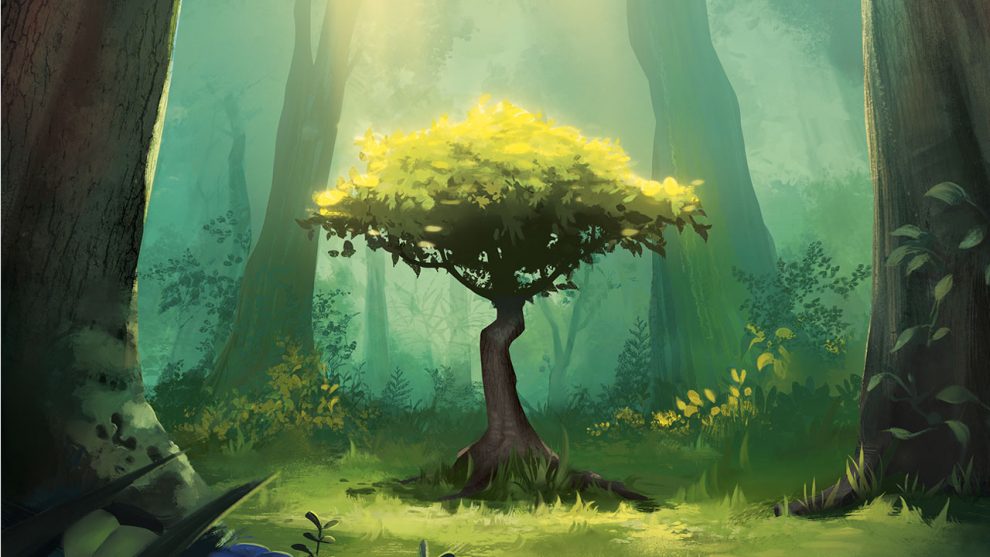Coming right on the heel of their recent Spiel des Jahres win for Kingdomino, Blue Orange Games presents their brand new game Photosynthesis – a game about soaking up the sun, spreading seeds, and growing and harvesting trees. The game’s gotten a lot of buzz, but does it deserve all of the attention?
Overview
So, there I was, sitting in my living room with my wife poring over the thousands of planned events for Gen Con trying to decide which ones we should add to our wish list. One game, in particular, captured our attention. It was bold and colorful and eye catching and the summary of the gameplay sounded intriguing. Not knowing much about it, we went ahead and added it to our wish list. And thus it was that, come Gen Con, we found ourselves sitting across the table from another husband and wife team getting ready to play Photosynthesis for the very first time.
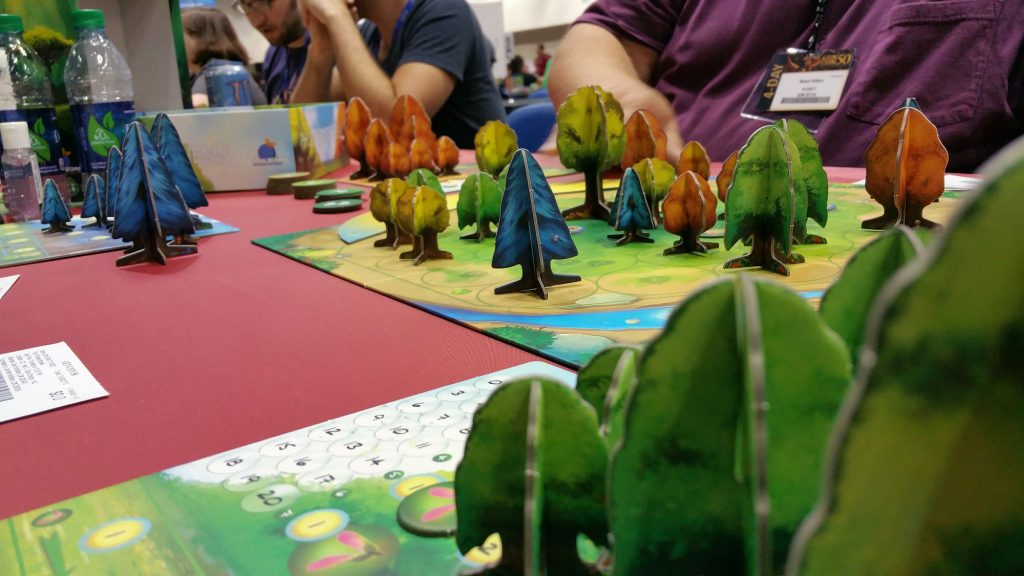
Designed by relatively new designer Hjalmar Hach, Photosynthesis has quickly climbed its way through the ranks of Boardgamegeek’s Hotness list and it shows no signs of letting go. It’s a game about collecting sunlight to grow and harvest trees, but it’s so much more. In between the players is an empty field divided into several zones culminating in a single circle in the center of the map. Each zone corresponds to a stack of victory point tiles. Growing a tree and harvesting it from one of these zones entitles the player to the topmost (i.e. – highest valued) tile from the appropriate stack. At the end of the game, the player that has collected the most points wins.
If you’re already familiar with the game and how it plays, then feel free to skip on ahead to the Thoughts section. Otherwise…
Contents
Photosynthesis is packaged inside of a very attractive box that features a tiny tree struggling for survival in a forest glade amongst the roots of towering behemoths. The artwork paints a stark contrast between the soft pastels of the little-tree-that-could and the harsh colors of its domineering neighbors. It evokes a sense of struggle and hope. Artist Sabrina Miramon has done a phenomenal job, not just here but throughout the game as a whole. Her artwork draws you in and makes you want to walk over and see what’s going on. Then the mechanics take over and do the rest. But I am getting ahead of myself.
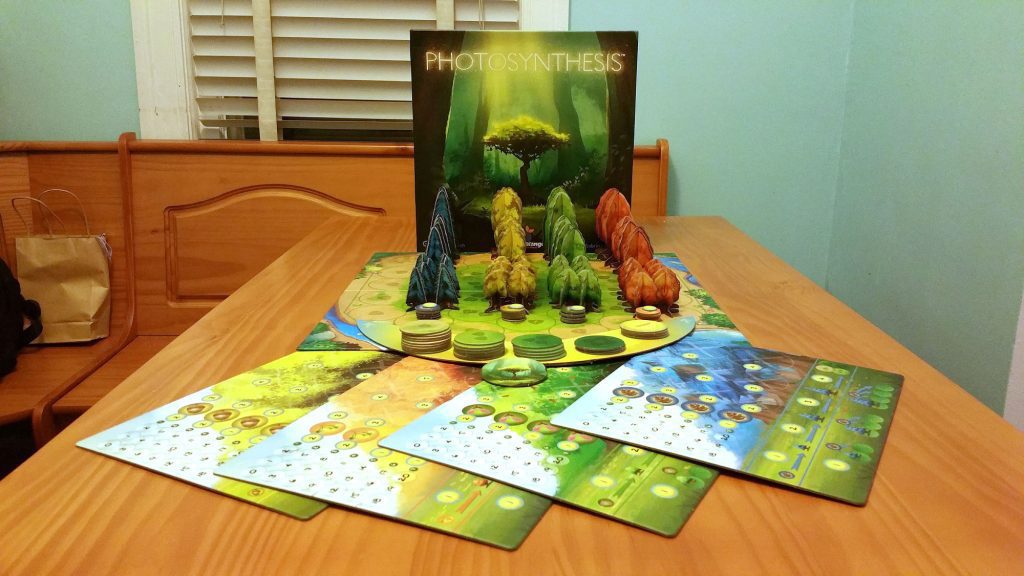
Opening the box you will discover 4 player boards in different colors (green, blue, yellow, and orange) along with an assortment of seed tokens and trees of different sizes that correspond with each color. The trees range from small to medium to large.
There are also 4 small Light tokens that are used to track the collection of light on the player boards, 4 round markers, a start player token, the game board itself, a large half-moon shaped object that represents the sun, several victory point tiles that are emblazoned with a number on one side and some leaves on the other, and the rule book. The card board here is nice and thick and has a heavy duty tactile feeling to it. The rule book is well written and contains plenty of examples.
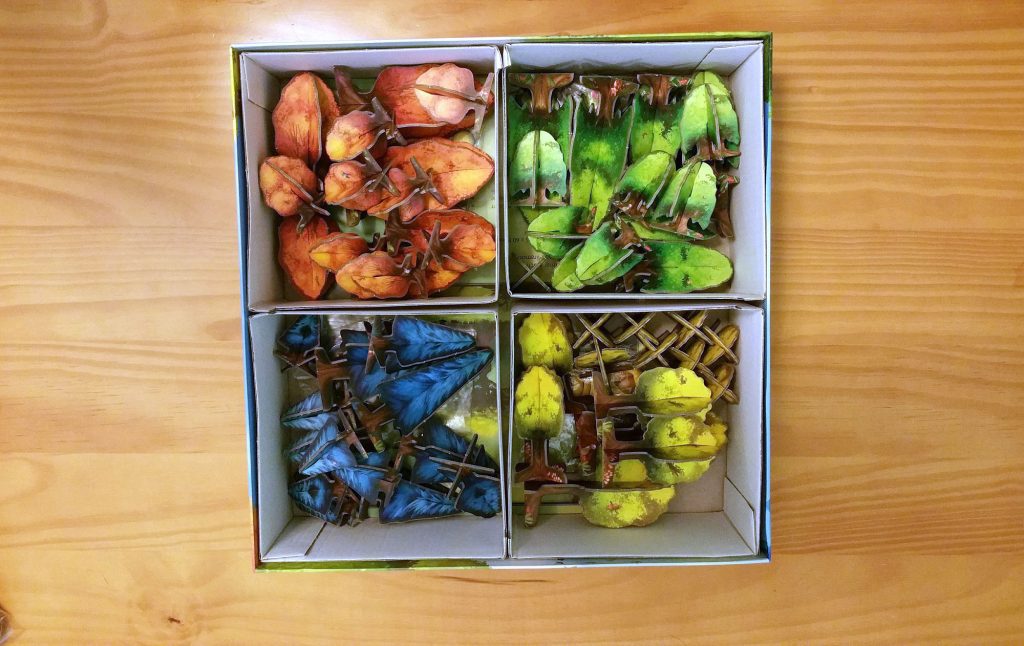
One thing of note here is that the box also includes four white dividers that are used to segment the box into different compartments. This is a rather ingenious storage solution and I find it highly impressive. However, I do wish that there had been a few plastic bags included as well to better contain the various tokens. The tokens have a tendency to slide underneath the dividers which makes them a pain to dig out if you’re not playing with a full assortment of players. This invariably means having to empty all of the trees out of the compartment, gather up the runaway tokens, and then having to place all of the trees back into their compartment again. This kind of mild irritation could be avoided altogether with just a few cheap little bags. Thankfully, I have a large collection of plastic bags that I’ve accumulated over time so I was able to quickly rectify this. But not everybody has these things which is why I am mentioning it here. Blue Orange could remedy this in future printings.
Setup
Each player chooses a color and takes the player board and the various tokens and trees associated with that color. Each player also receives a single Light token which is placed onto the 0 spot on their player mat. The trees are placed onto their corresponding areas of the player mat as well as the seedling tokens. There will be a few trees and seedling tokens that do not fit onto the player mat. These trees are set to the side in an area which we will call the ‘readied area’.
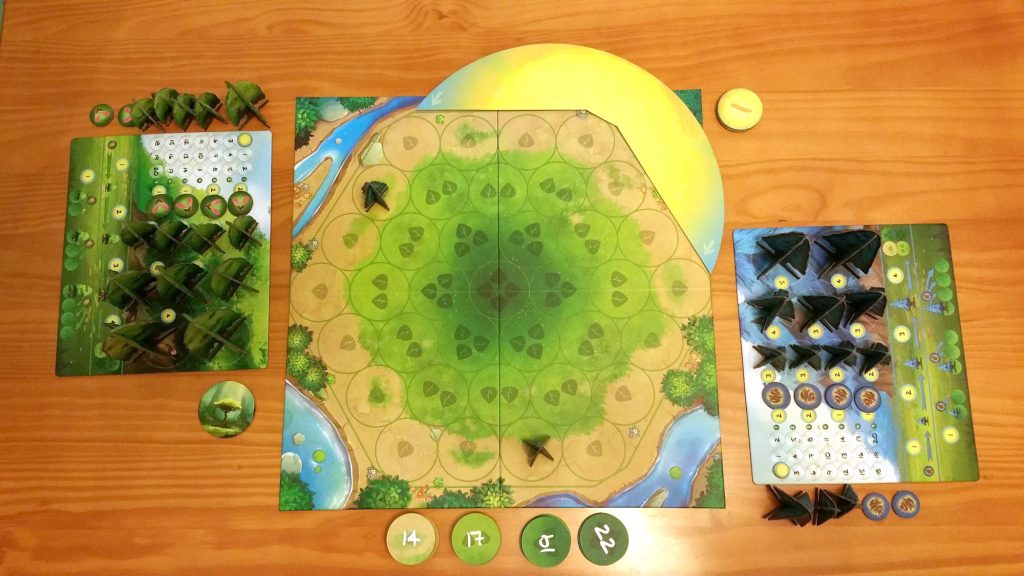
The gameboard is laid out between the players. The half-moon sun (which I will henceforth refer to as the ‘sundial’) is laid alongside of the edge of the board on top of the sun icon. Next to this are placed the round markers in ascending order with the lowest number on top. Then the victory point tiles are arranged according to the number of leaves pictured on their backs. These are placed into separate piles in descending order with the highest number visible on top. Once this initial setup is complete, the players will select a start player by some means who will take the start player token.Then, in turn order, they will take turns placing one tree at a time onto one of the empty spaces along the outer ring of the game board. Once everyone has placed two trees apiece, you’re ready to begin.
Harvesting Sunlight
As Photosynthesis plays on, the sundial will move around the edges of the board. This will cause any trees that are not blocked by other trees to receive sunlight which is tracked on the player board. Each tree has a specific height (small = 1, medium = 2, large = 3) and this height is used to not only determine how much sunlight a tree receives, but also how much of a shadow it casts on other trees. This is the single most difficult concept to wrap your head around when it comes to this game and it is best done with an example. Consider this photo:
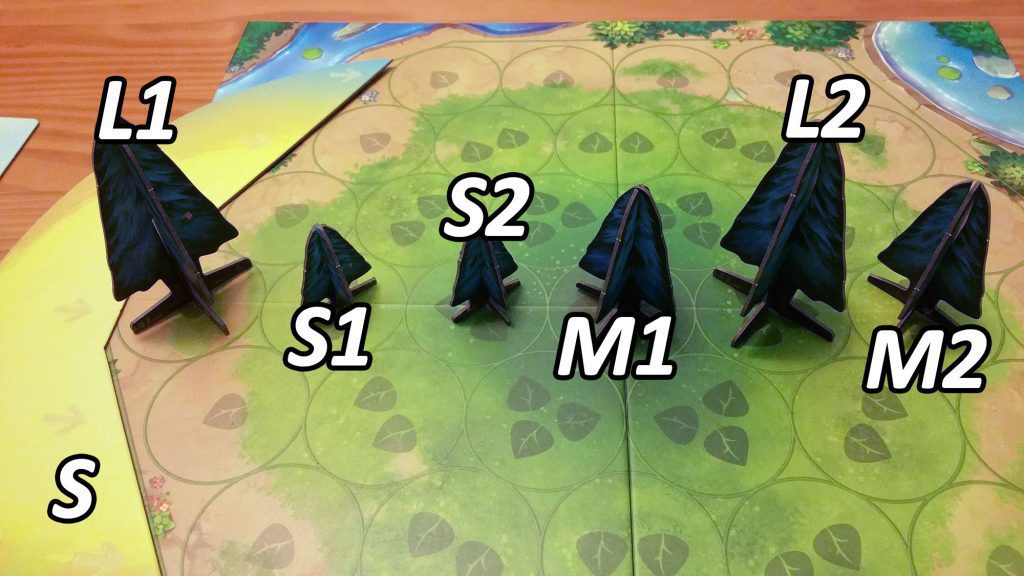
In this example, we have five trees in a row. Because of the position of the sundial, the first tree that is receiving light is the large tree in front followed by the two small trees, a medium tree, another large tree, and a second medium tree. I made all of the trees the same color just for example’s sake. All of the trees receive sunlight. After you figure out how much light each tree receives, you need to determine how much of that light is blocked by the trees in front of it. So, let’s break down the example so that this makes better sense. I’m going to use this notation when talking about it:
Sun = S, Large Tree #1 = L1, Small Tree #1 = S1, followed by S2, Medium Tree #1 = M1, Large Tree #2 = L2, and Medium Tree #2 = M2
L1 = 3 light received
S1 = 1 light received
S2 = 1 light received
M1 = 1 light received
L2 = 3 light received
M2 = 2 light received
As I touched on earlier, each tree also casts a shadow which prevents light from reaching any shorter trees in its shadow. Large trees have a shadow of 3 spaces, medium trees have a shadow of 2 spaces, and small trees have a shadow of one space. All trees cast shadows regardless of the total amount of light they ultimately produce. This shadow casting has two effects. Firstly, they block a certain amount of light from reaching the trees that are directly behind the tree that is casting the shadow. Secondly, they block the light from reaching trees a certain number of spaces behind the tree that is producing the shadow.
L1 has a shadow of 3 spaces, so it blocks the 3 spaces behind it completely. This means that S1, S2, and M1 produce 0 light points. Next up is L2 and this is where things can start to get confusing. Even though M1 is going to produce 0 light points, it STILL casts a shadow of 2 spaces. This means that L2 is only going to generate 1 light point as the tree directly in front of it, M1, has blocked 2 of the light that it would receive. Lastly, since M2 falls within the shadow of both M1 and L2, it doesn’t receive anything at all. If you were to remove L2 from the equation, M2 still would not receive anything as it is within range of M1 and they are of the same height. In this example, the player would only receive a total of 4 light points (3 from L1 and 1 from L2) for this turn.
Wrapping your head around these concepts is the hardest part about learning this game. It’s not as convoluted as it sounds, though. After one or two sample rounds, you’ll be quickly calculating how much each of your trees is going to produce without any trouble. As humans, we tend to think of shadows as angled things. In this game, though, your tree is more like a Tron cycle and the shadow is the band of light that is trailing along behind it.
What Goes Up Must Come Down
While the sunlight harvesting portion of the game is the hardest part of the game to understand, it’s the process of actually growing your trees that is the most important. At the beginning of the game, there will be several trees and seedlings that are ready to go, but in order to produce more sunlight, it’s going to require more trees and obtaining those is going to cost you more sunlight. As the saying goes, you’ve got to spend money to make money.
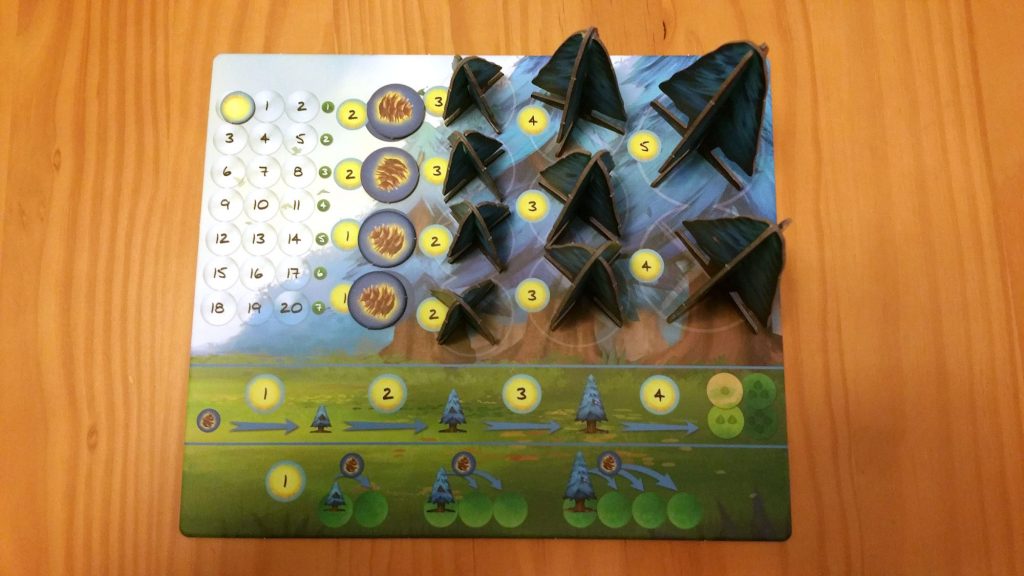
On your player board are 4 seedlings, 4 small trees, 3 medium trees, and 2 large trees. Beside each of these is a number in a circle. This number indicates how much sunlight must be spent in order to move the item from your player mat into your readied area. You can pull them off of your mat in whichever order you choose, but you will most likely be pulling off the cheapest things first.
Once an item is in your readied area, it is ready to be added to the game board. There are certain sunlight costs associated with placing things on to the game board and these are all shown along the bottom of the player mat. For instance, upgrading a seedling into a small tree will cost 1 sunlight. Also displayed on the game board are some rules about how seedlings can be added to the board. Small trees can cast a seedling 1 space away. Medium trees can cast up to 2 spaces away, etc. Casting a seedling will cost you 1 sunlight. When an item is upgraded (i.e. – turning a small tree into a medium tree) the old item is replaced with the upgrade and then the old item is returned to your player mat if there is a space for it. If not, the old item is removed from the game.
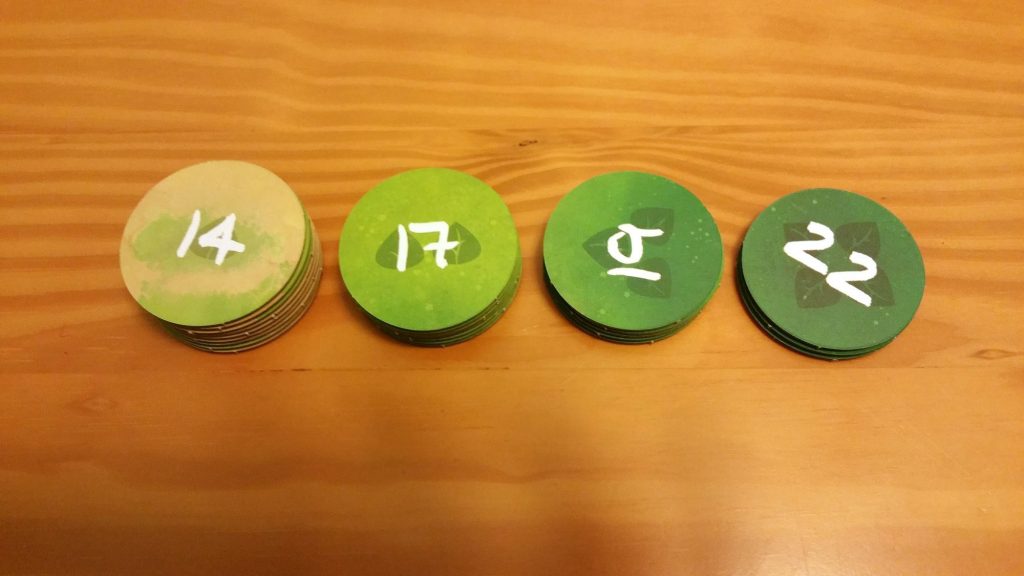
Once a tree has become a large tree, it can be cut down for a cost of 4 sunlight. The tree is returned to your player mat and then you will take the top token from the appropriate victory point tile stack. For instance, if you cut down a tree that was in the 2 leaf ring, you would take the top token from the 2 leaf stack.
Anatomy of a Round
Aside from the very first round, each round begins with the sundial moving into a new position along the edge of the board. Then the players calculate how much sunlight they are receiving followed by each player, in turn, spending their light in whatever fashion they wish. They can even hang onto unspent light and carry that into future rounds. Once the players have finished their turns, the start player token is handed to the next player, the topmost round marker is removed, and a new round begins.
Things continue in this fashion until the sun has made 3 to 4 rotations (you can choose which to go with during the game setup) and then everyone adds up the victory point totals on their victory point tokens. The player with the highest total is the winner.
Thoughts
The very first thing that drew me to this game was the artwork and I have a feeling that many people will say the same thing; it’s just a beautiful game. Once the game is in full swing and the game board is covered in little 3D trees, it’s almost impossible for a passerby to not stop dead in their tracks to take it all in. Photosynthesis is just a very fetching game with an amazing table presence. A good game is a sum of all of its parts. The artwork is just a smaller piece of the puzzle, but it’s the essential piece that made me want to put the puzzle together in the first place. So, once again, my hat’s off to Sabrina Miramon for her amazing artwork. If nothing else, Photosynthesis is one of the best looking games that I have ever played.
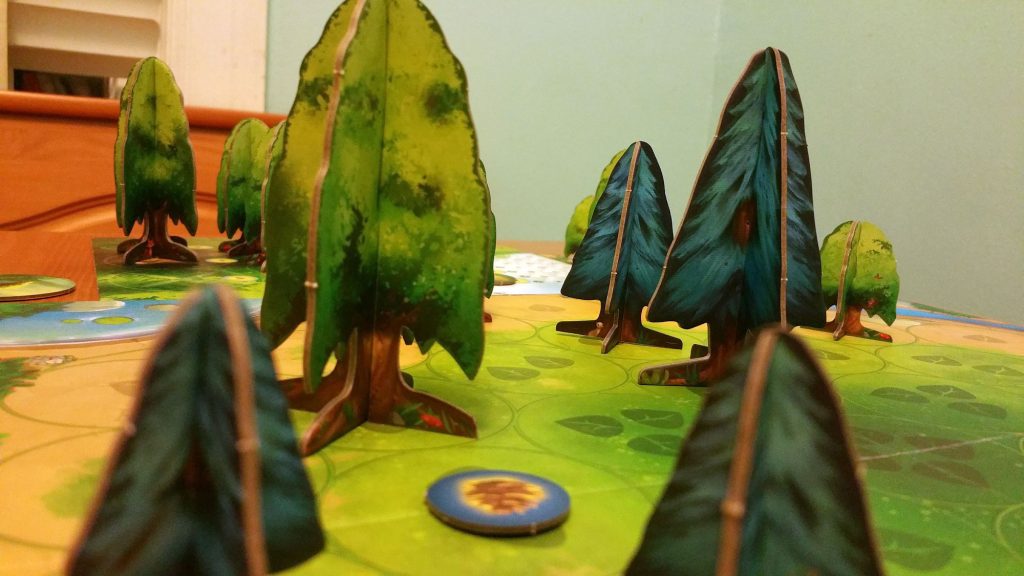
Before I get into what I like about the game, I’d like to take a moment to talk about a few small things that bother me. While the rule book does an excellent job of explaining the game, the example image that it provides to describe how the shadow casting works definitely needs a few more examples. There have been quite a few times that cases have appeared during my gaming sessions that the rule book doesn’t adequately answer. Instead, we had to either house rule a thing or go through the words in the rule book with a fine toothed comb to try and come up with the proper answer. Also, the lack of plastic bags really bothers me. It’s something pretty small and I know that it shouldn’t bother me the way that it does, but it bugs me nonetheless. Finally, while I really like the name of the game, it makes me wish that the game were more about the process of photosynthesis rather than about growing and harvesting trees. Just take a look at my review of Cytosis to see what I mean. Now, on to the good stuff!
Gameplay-wise, Photosynthesis is one of the most unique games that I have ever experienced. When I sat down to play it for the first time, I had no idea what to expect. I only knew that it was a game about growing trees and casting shade, but mechanically, I was in the dark (pun totally intended). After hearing how the position of the sundial determined how much sunlight each person would receive, I immediately began seeing how a savvy player could position themselves in a way to gobble up all of the sun while denying it to the other players. I realized that the first player to the coveted middle spot could effectively hog that spot for the entire game if they so chose and my brain began trying to determine the best way to defeat this strategy. Before I’d even collected a single piece of sunlight, my mind was already spinning with possibilities. Even though I’d just met Photosynthesis for the first time, I was already in love.

I’ve played 7 or 8 games of Photosynthesis since that very first encounter and it reignites that same passion each and every time. Even though the decisions from one game to the next aren’t anything new, the actions of the other players always bring a freshness to the table. Photosynthesis is a game that rewards having backup plans and counter strategies in place. Whatever your plan, whatever your strategy, you can always count on someone else screwing it all up. I like that; it keeps me on my toes. While undeniably devastating, the player interaction in this game never feels merciless or cruel. Sure, it’s inconveniencing in the moment, but the sundial will always eventually move into a position that is more beneficial for you than it is for your opponents. You just have to prepare for it and be ready to make the best use of that opportunity when it comes around.
I am also blown away by the game’s mechanics. I have never seen anything like them before. The shifting sunlight, the shade, the harvesting of the sunlight… these are all interesting and unique things that have been combined to form a game that is easy to grasp, elegantly designed, fun to play, and challenging to master. These, coupled with its language independent design and the artwork which I have already gushed about, leave me no doubt that Photosynthesis will emerge as one of the top games of 2017. I would be surprised if it weren’t nominated for next year’s Spiel des Jahres. In fact, it wouldn’t surprise me at all if it won it outright. It’s just that good of a game. I highly recommend adding Photosynthesis to your game library. I’m glad I did!


